According to many experts, chronic prostatitis is an inflammatory disease, the cause is infection that is likely to increase autoimmune disorders, characterized by the organs of the organs.The disease has known medical since 1850, but today it has not been fully researched and poor treatment.Chronic prostatitis (6 - 10%) and not born (80 - 90%) are the most common and social diseases in men significantly reducing their quality of life.The disease is recorded mainly in young and middle -aged people and is often complicated due to weak intercourse and general functions (reducing effect, infertility, etc.).The disease is recorded in men in 8 - 35% of cases from 20 to 40 years old.
The cause of bacterial prostatitis is a pathogenic flora that enters iron from the urethra, or lymphogens and hematology.The cause of prostatitis is not chronic biological and its pathology is not known.Most of them suffer from men over 50 years old.
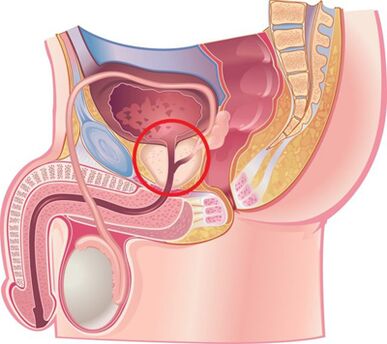
Causes of the development of the disease
Chronic prostatitis is now considered a general disease.There is an idea that the disease occurs due to the invasion of the infection on the prostate, and then the pathological process does not have its participation.This is facilitated by some non -infection factors.
Infectious factors in the development of chronic prostatitis
In 90% of cases, pathogens penetrate the gland from the urethra, leading to acute or chronic prostatitis.There have been cases where transportation has no symptoms.The process of the disease is affected by the defense state of the human body and the biological properties of the pathogen.It is thought that the transition from acute to chronic prostatitis occurs due to loss of elasticity of tissue due to too much fiber tissue production.
The following pathogens are found among chronic prostatitis factors:
- In 90% of cases, the disease manifests Gram -negative bacteria such as Escherichia Coli (Escherichia Coli), Enterococcus Faecalis (Enterococcus), and less common - Pseudomonas Aeruginosa, Klebsiella sppAcinetobacter spp.Gram -positive bacteria Enterorococci, Streptococci and Staphylococci are rare.
- The role of coagulase-free staphylococci, ureaplasma, chlamydia, trichomonas, Gardnerella, anaerobic bacteria, and fungi of the genus Candida has not been fully elucidated.
Infections enter the prostate in several ways:
- The upward path is most likely to occur, as evidenced by a regular combination of prostatitis and urethritis.
- Prostatitis by blood sugar develops when infection penetrates glands through blood, is observed in chronic tonsillitis, sinusitis, periodontitis, pneumonia, cholecystitis and cholecitis, pus -off skin diseases, etc.
- Chronic contact prostatitis develops with urethritis and strictures of the urethra, when the infection penetrates into the gland increasing with the flow of urine, with purulent infections of the kidneys, canalicular due to epithelium, arthritis and during diagnosis and treatment by therapeutic methods)
- Lymphocytic infection infiltrates the prostate with proctuses, thrombosis of hemorrhoidal veins, etc.

Noninfectious factors in the development of chronic prostatitis
Chemical elements
According to experts, the leading role in the development of chronic prostatitis belongs to intraprostatic reflux of urine when urine is discharged from the urethra to the iron, leading to a violation of the emptying of the prostate and semen sacs.
With the disease, the blood vessel reactions develop into the edema of the organ, the nerve regulation and humor of the tone of the plain muscle tissue of the urethra and the activation of the disturbed alpha.1“drenoreceptors cause the development of dynamic obstruction and contribute to the development of new intrahepatic reflux.
Urates contained in urine, with reflux, lead to the development of a “chemical” inflammatory reaction.
Hemorrhagic disorders
Support chronic inflammation of circulatory disorders in pelvic and scrotum organs.Development stagnation in people with sedentary lifestyle, for example, for drivers, office workers, etc., with obesity, sexual disorders, sexual disorders, regular body temperature, mental and physical overload.Maintain inflammatory process, use spicy and spicy foods, alcohol and smoking, etc.
Other factors
There are many other factors that support chronic inflammatory processes in the prostate.They include:
- Hormonal.
- Biochemistry.
- Violation of immune response.
- Autoimmune mechanism.
- Infectious and allergic processes.
- The features of the structure of the prostate, leading to the difficulties of the full drainage system.
Very often, it is not possible to establish the causes of chronic prostatitis.
Classification of prostatitis
According to the classification proposed in 1995 by the US National Institutes of Health, prostatitis is divided into:
- Sharp (type I).Is 5 - 10%.
- Chronic bacteria (type II).Is 6 - 10%.
- Chronic rheumatoid arthritis (type IIIA).It's 80 - 90%.
- Chronic non-inflammatory (type IIIB) or chronic pelvic pain syndrome.
- Chronic prostatitis is discovered incidentally (type IV).
Signs and symptoms of chronic prostatitis
The process of chronic prostatitis is long but not monotonous.The periods of exacerbation are followed by periods of relative calm, which occur after treatment with complex anti-inflammatory and antibacterial drugs.
The development of chronic bacterial prostatitis is often preceded by urethritis of a bacterial or gonorrheal nature, non-bacterial circulatory disorders in the pelvic organs and scrotum (hemorrhoids, varicocele, etc.), excessive sexual intercourse.
Patients with chronic prostatitis have many complaints.They have been going to the doctor for many years but rarely have their prostate examined.About a quarter of patients do not have any complaints or the disease occurs with very few clinical symptoms.
Complaints of patients with chronic prostatitis can be divided into several groups.
Urinary disorders related to urethral stricture:
- Initial difficulties when urinating.
- Weak urine stream.
- Pyxing interruption or drip.
- The feeling of bladder empty is incomplete.
Symptoms due to irritation of nerve endings:
- Frequent urination.
- The urgency is sharp and strong.
- Urine in small portions.
- Urine is not self -control when you want to urinate.
Pain syndrome:
- The intensity and nature of pain is different.
- Pain localization: lower abdomen, area of the perineum, rectum, groin and lower back, inner surface of the hips.
Sexual dysfunction:
- Pain in the rectum and in the urethra during ejaculation.
- Sluggish erection.
- Losing orgasm.
- Premature ejaculation, etc.
From the nervous system: neurological disorders in the form of repairing patients' attention in their health status.
Signs and symptoms of chronic prostatitis
Chronic pelvic pain in men (CFTB) conducts symptoms common to chronic prostatitis, but in the 3rd part of the urine and the secret of the prostate in bacterial studies are absent.CTB simulation can simulate chronic Nebacterial interstitial cystitis, rectal diseases, pelvic floor spasms, myofascial spasms, and functional prostatitis caused by impaired organic organ innervation and its hemodynamics.
In case the nerve function is weakened, the change and weakening of the conservation of the gland are recorded, manifested by the difficulties of the quick and complete closing of the urinary tract of the urethra.At the same time, urine, after urinating, continues to stand out for a long time.In such patients, in the study, the instability and stimulation are found, manifested by increasing sweat and irritability of heart activity, dermatological changes.
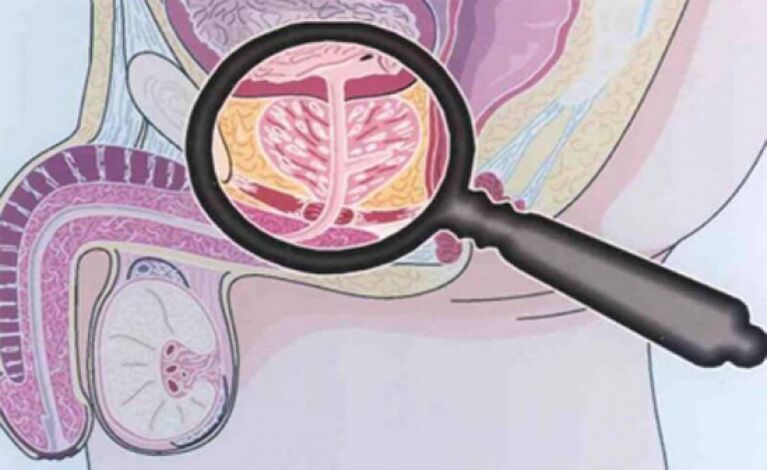
Complications of the disease
The long course of chronic prostatitis is complicated by sexual and reproductive dysfunction, the development of diseases such as vesiculite and epitheliitis, as well as sclerosis of the organ.Stiffening of the organ worsens local microcirculation and urodynamics, as do the results of surgical interventions.Fibrosis of perihumetral tissues leads to the development of urinary disorders.
Diagnose
Due to the fact that there are many reasons for the development of chronic prostatitis, a variety of diagnostic studies are used to diagnose it.The success of treatment depends on accurately determining the cause of the disease.Diagnosis of chronic prostatitis is based on the following data:
- The classic trio of symptoms.
- A complex of physical methods (finger rectal examination of the prostate).
- A complex of laboratory methods (analysis of urine and microscopes of the prostate, sowing and determining the sensitivity of the microorganism system for antibacterial drugs, urine and blood analysis in general).
- To detect gonococci, colonized bacteria from the urethra, PCR and serological methods (to detect ureapes and chlamydia).
- Urofluometry.
- Prostate biopsy.
- A complex of instrumental methods (ultrasound).
- Determine the patient's immunity.
- Determine nervous condition.
- With the inefficiency of treatment and doubt about the development of complications, magnetic resonance images and calculation, blood sowing, etc.
Palpation of the prostate
Palpation of the prostate, increased during exacerbation and decreased during the subsidiary phase of the inflammatory process, is of paramount importance in the diagnosis of the disease.In chronic prostatitis, during exacerbation of iron there is swelling and pain.
The density of the consistency of the agency may vary: the soft and compressive areas are touched, the western areas are determined.When palpable, the shape of the gland can be assessed, the condition of the particles and surrounding tissues.
The process of checking the finger through time is combined with the arrest of the route.Sometimes it is necessary to have a secret from each stock.
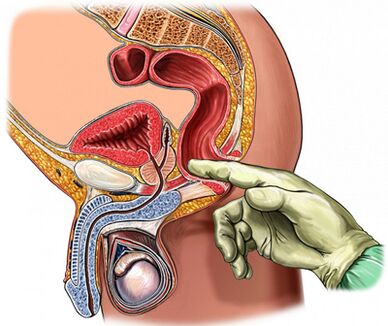
Analysis of 3 cups of urine and secrets of the prostate gland
The gold standard in diagnosing chronic prostatitis is:
- The first collection of urine.
- The second part of the urine.
- Get the secret of the gland by massage.
- The third urine collection.
Next, a microscopic and bacteriological examination of the material is performed.
With prostatitis:
- Number of microorganisms (CFU) exceeds 103/ml (104/ml for epidermal staphylococci), but should not be ignored by a small number of bacteria calculated by tens and hundreds.
- The presence of 10-15 leukocytes in the field of view detected microscopically is a generally accepted criterion for the presence of an inflammatory process.
The secret of the prostate and the third part of the urine must be subjected to bacterial and bacterial studies:
- In chronic bacterial prostatitis, an increase in the number of leukocytes in the secret of the gland and the third part of the urine is noted, bacteria (mainly intestinal groups) are released.
- With prostatitis is not bacteria, the increase in the number of white blood cells in the secret of the gland is recorded, but there is no microbiological system.
- With CTB, there is no amount of white blood cells and microorganisms.
The normal index of the secret of the prostate:
- Leukocytes are less than 10 in viewing fields.
- Lecithine particles are a large number.
- There is no microbiome.
In chronic prostatitis in the secret of the prostate it is found:
- The white blood cell count is large 10-15 in the field of view.
- The amount of lecithin seeds is reduced.
- The pH of excretion is shifted to the alkaline side.
- The content of acid phosphatase is reduced.
- Lysozyme activity is increased.
Obtain negative results of the secret of the prostate once the lack of inflammatory process is proven.
The value of the secret test of the prostate is still.Typically, in the crystallization process, a typical model is formed in the form of a fern.In case of violation of the combined properties of the prostate secret, such a model does not form what happens with changes in Androgen hormones.
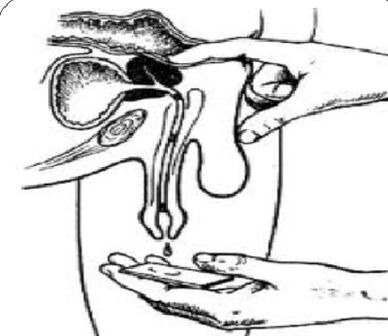
Check ultrasound
If prostate disease is suspected, ultrasound examination of the gland (transrectal ultrasound), kidneys and bladder is optimal, allowing us to determine:
- Volume and size of the gland.
- Presence of stones.
- The size of the seminal vesicles.
- Condition of the bladder wall.
- The amount of urine remaining.
- Structure of the scrotum.
- Another type of pathology.
Other prostate examination methods
- Hemorrhagic state (research on urine flow rate) can be easily and simply determined by using a study such as measuring urine flow.With the help of this study, it is possible to promptly detect signs of congestion to the bladder and conduct dynamic monitoring.
- Perforated biopsy is performed if it is suspected of forming abscess, benign hyperplasia and prostate cancer.
- To clarify the cause of obstruction under the bladder, X-ray and endoscopic examination are performed.
- In the case of prolonged inflammation, urethral endoscopy should be performed.
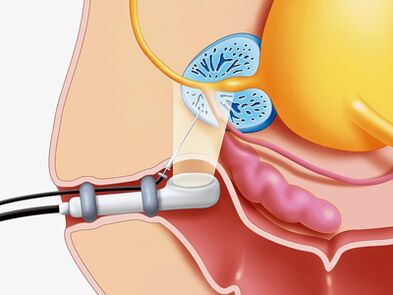
Differentiate diagnosis
Chronic prostatitis should be distinguished from IC, autonomic prostatic disease, stagnant prostatitis, sub-pelvic perineal, dysfunctional psychopathology, sexual dysfunction, sexual dysfunction.Hypertrophy of the bladder neck, stricture of the urethra, tuberculosis, cancer of the prostate and bladder, urolithiasis, chronic epididymitis, inguinal hernia.
Treatment of chronic prostatitis
Treatment of chronic prostatitis should start with a change in the patient's lifestyle and nutrition.
In the treatment of diseases, drugs are used that simultaneously affect various links of pathogenesis.
Main treatment directions:
- Eliminate human microorganisms.
- Anti-inflammatory therapy.
- Normalizes blood circulation in the prostate and pelvic organs.
- Normally, adequate drainage of prostate acinus.
- Normalizes hormonal profile.
- Prevention of organ sclerosis.
To treat chronic prostatitis, the medicine of the following groups is used:
- Antibacterial.
- Anticholinargic.
- Vasodilators.
- Alpha1Prohibition -blocking.
- 5 alpha reductase inhibitors.
- Cytokine inhibitors.
- No inflammation.
- Angioprotectors.
- Immune treatment kit.
- Preparation affects urates metabolism.
Antibiotics in the treatment of chronic bacterial prostatitis
Antibacterial therapy should be taken into account the sensitivity of microorganisms detected with antibiotics.In the absence of germs without germs, experimental anti -bacterial treatment is used.
The drugs of choice are fluoroquinolones of generations II - IV.They quickly penetrate the glandular tissues with conventional methods of use, showing activity against a large group of Gram-Negative microorganisms, as well as ureaplasma and chlamydia.In case of failure of antibacterial treatment, it is necessary to assume:
- Polyurezancy,
- Short treatment courses (less than 4 weeks),
- Inaccurate options of antibiotics and its dosage,
- Change the type of pathogens,
- The presence of bacteria living in the pipes of the prostate is covered by a protective extracellular membrane.
Treatment time should be at least 4 weeks with mandatory bacterial control later.In the case of storage in the third part of the urine and the secret of the prostate of the bacteria3The correspondence of a retreatment therapy for a period of 2 to 4 weeks is prescribed.
Cytokine inhibitors in the treatment of chronic prostatitis
Cytokines are glycoproteins secreted by immune cells and other cells under conditions of inflammatory and immune responses.They actively participate in the development of chronic inflammatory processes.
Nonsteroidal anti-inflammatory drugs
Steroid anti -inflammatory drugs have anti -inflammatory and analgesic effects and fever.Widely used in the treatment of chronic prostatitis in the form of tablets and bullets.The most effective line is rectal.
Immunotherapy
In the treatment of chronic prostatitis caused by bacteria, in addition to antibiotics and anti -inflammatory drugs, immunosuppressive drugs are used.The most effective is the rectal line.An immune air conditioner is widely used, increasing the functional activity of the phagocytes, contributing to the elimination of pathogens more effectively.
Alpha blockers in the treatment of chronic prostatitis
It has been established that alpha-1 adrenergic blockers normalize the tone of the smooth muscles of the prostatic urethra, seminal vesicles and prostatic cysts, which makes drugs in this group very effective in the treatment of the disease.Alpha-1 adrenergic blockers are used in patients with severe urinary disorders without an active inflammatory process.
For CPPS, treatment duration ranges from 1 to 6 months.
5A Reductase inhibitors in the treatment of prostatitis but KTBB
It has been determined that under the influence of the 5A Reductase enzyme, Testosterone turned into a 5A-Dihydotosterone prostate form, the activity of the prostate cells is 5 times higher than the activity of testosterone, in the elderly leading to an increase in the organ.
When taking 5A reductase inhibitors for 3 months, tissue atrophy is observed; for 6 months, the secretory function is inhibited, the severity of pain and the volume of the gland are reduced, the tension and edema of the organ are reduced.
The role of anti -bacterial drugs in the treatment of chronic prostatitis
With long-term development of inflammation in the prostate, fibrosis develops, which is manifested by disorders of microcirculation and urethra.To prevent fibrosis, anti-inflammatory drugs are used.
Other drugs are used in the treatment of chronic prostatitis
Along with the above drugs, the disease is used to treat:
- Antihistamines.
- Vasodilators and angioprotectors.
- Immunosuppressive drugs.
- Preparations affect urate exchange and trinatri salt of citric acid.
Vegetable products
Effective in the treatment of prostatitis, the use of the drug in the form of candles contains a complex of biologically active peptides isolated from the prostate of cattle.
Under the influence of the drug,:
- Stimulate metabolic processes in the tissues of the gland.
- Improve microcirculation.
- Reduce edema, white blood cell infection, stagnation and pain.
- Prevention of thrombosis in the veins of the prostate.
- Increase the activity of the excretory epithelium of acinus.
- Improve sexual function (increase libido, rehabilitate erectile function and normalize sperm biochemistry).
Finger massage of the prostate
Some researchers say that in chronic prostatitis, finger massage should be used, taking into account known contraindications.
Physical therapy
The effectiveness of physiotherapeutic procedures in the treatment of prostatitis is not proven today, the mechanism of action has not been scientifically established, adverse reactions have not been studied.
Prevention of chronic prostatitis
To begin preventing the development of chronic prostatitis, you should know:
- The risk of disease development has increased over the years.
- Representatives of the Negroid race are more susceptible to the disease.
- A familial predisposition to the disease cannot be ruled out.
People who tend to develop chronic prostatitis should pay more attention to their health status.
Tips to prevent disease:
- Drink enough liquid.Regular urination helps remove the microflora from the urethra.
- Prevent diarrhea and constipation.
- Compliance with a balanced diet.Avoid eating foods rich in carbohydrates and saturated fat, leading to weight gain.
- You should minimize the consumption of the urethral irritants: hot spicy food, smoked food, sauce and spices, coffee and wine.
- Stop smoking.Nicotine negatively affects the condition of the vessel walls.
- Don't be too cold.
- Do not hold back your bladder empty.
- Have an active lifestyle and play sports.Perform exercises to strengthen the pelvic muscles, help eliminate venous blood stagnation, thereby maintaining normal prostate function.
- There is regular sex life.Avoid prolonged abstinence.The route must be cleaned in a timely manner.
- Commit to maintain the monogamy.Indiscriminate sex increases the risk of sexually transmitted diseases.
- If you have complaints about your genitals, contact your urologist immediately.
































